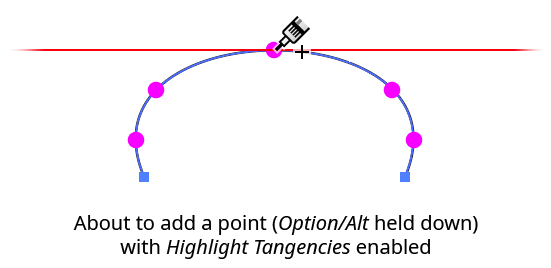 Path Segment Operations
Path Segment Operations
When a path is at least partly-selected, its segments may be edited in several ways:
Clicking a path segment does nothing unless the tool preference Click-Drag Segments to Reshape has been disabled (in that case, clicking adds an anchor point to the path segment at the clicked location).
Option/Alt-clicking will add an anchor point to the path segment, as long as the tool preference Option/Alt-Clicking Inserts New Point in Path has not been disabled. The cursor shows a “+” sign when an anchor point will be added. If the sub-preference Snap to Tangencies is enabled, the cursor will snap to vertical, horizontal and diagonal tangencies on the path segment (taking into account the general constrain angle). A red guide will appear when the cursor is snapping, indicating the tangent direction:

InkScribe Add Point Example
Additionally, you can choose to highlight all of the tangencies on the current path segment with a small magenta dot by enabling the Highlight Tangencies sub-preference:

InkScribe Add Point Highlight Tangencies
Dragging a path segment reshapes it, similarly to the Direct Selection tool (unless the tool preference Click-Drag Segments to Reshape is disabled). The closer the initial mouse-down is to one anchor point, the more that point’s handle movement is affected by the cursor movement and the less the other handle is affected. Starting the drag midway along the path between the points affects both handles equally. If the Keep Path Under Cursor When Dragging sub-preference is disabled, handles are still moved relative to the initial click location, but the path will not necessarily pass through the cursor position. If either of the segment’s handles does not exist at the start of the drag, new ones will be created. Adjacent segments will also be affected when you drag a segment if its endpoints are smooth points, since the opposing handles must change angles to remain 180° away from the moved handles.
Note: When you are using Recognize Connector Points, segments with connector points at one or both ends are affected differently by drags, since a connector point can have only one handle at a fixed angle; see Connector Points.
While dragging a segment, there are various keys which can be pressed to perform additional functions:
Shift: Reshapes the path segment while keeping it symmetric. Symmetric means that both handles are of the same length and are at the same angle to the imaginary line running through the endpoints of the path segment.
Shift-draggingfrom the middle third of a path segment will additionally constrain the handle angle to be perpendicular to this imaginary line:

InkScribe Path Drag Symmetrical Handles
Except for middle-third Shift-dragging, if you release the Shift key (or if you started dragging without it) and later hold it down, the curve will become symmetric using the lengths and angles of the handles as they exist at that moment.
Option/Alt: Constrains the angles of the handles to their original values (±180°). If you have the Option/ Alt-Clicking Inserts New Point in Path preference enabled, you must press the key after you hold down the mouse button, or you will inadvertently add a point to the path. But even if you begin to drag without
Option/Alt, holding it down afterwards will reset the angles of the handles to the angles they had when you originally moused down on the path. Note: If the initial mouse-down was close to one of the ends of the segment, the segment shape will probably be very sensitive to movement of the cursor.Shift+Option/Alt:
Shift+Option/Alt-dragginga path segment reshapes it with the following constraints: the handle lengths are kept equalized, and the handle angles are constrained to their original values. As withOption/Alt-dragging, handle angles will be set to the original angles unlessShiftwas held down by itself first (which will have made the curve symmetric). This allows you to first symmetrize a curve until the handles are at the angle you like, and then lengthen or shorten them without losing the symmetry.R: Retracts the handles of the path segment being dragged, making it straight.
